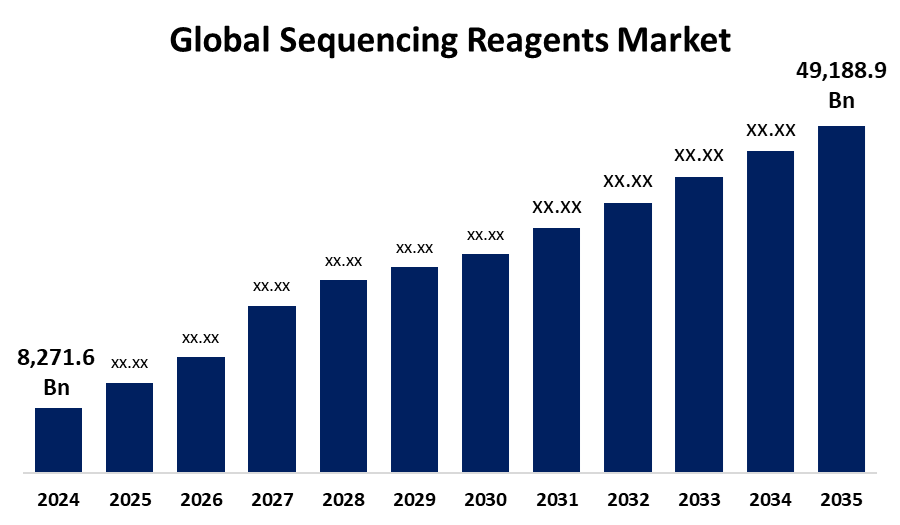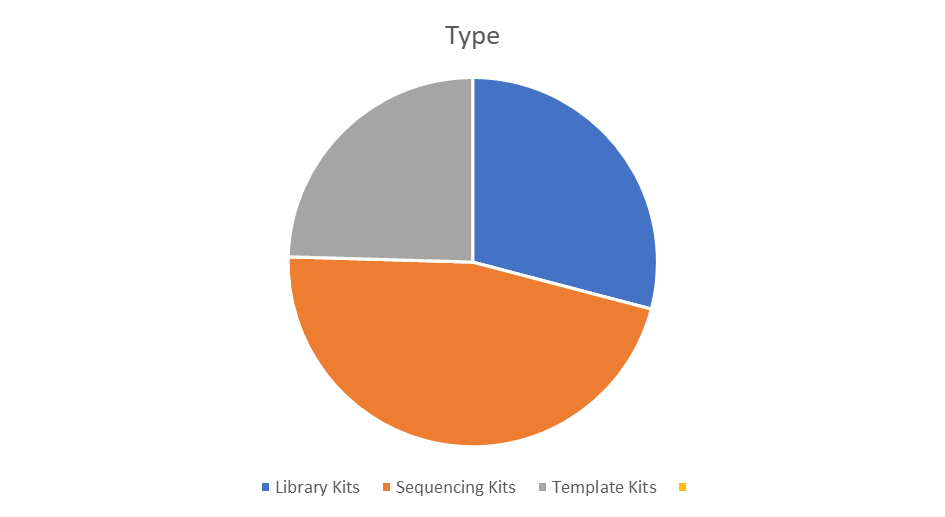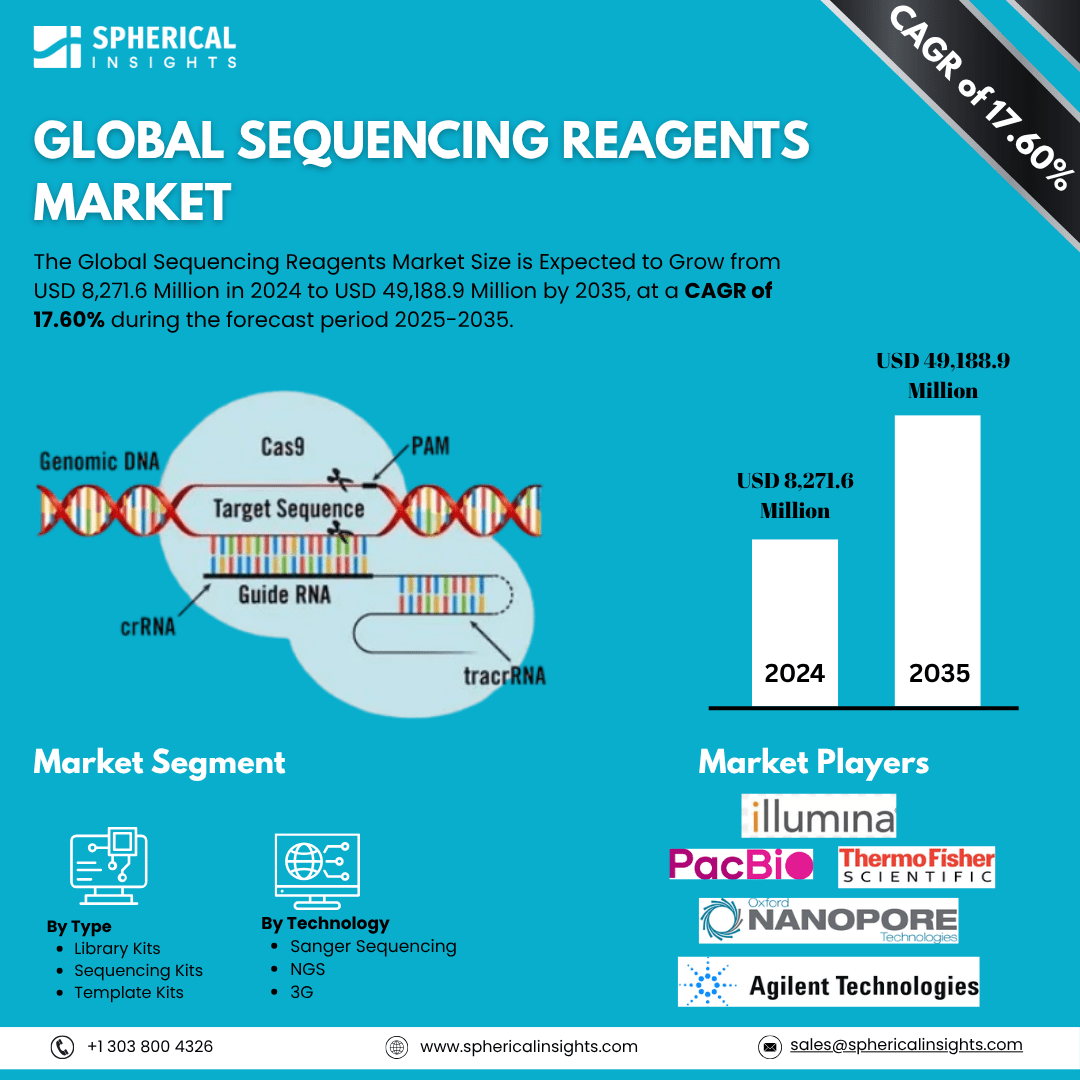Global Sequencing Reagents Market Insights Forecasts to 2035
- The Global Sequencing Reagents Market Size Was Estimated at USD 8,271.6 Million in 2024
- The Market Size is Expected to Grow at a CAGR of around 17.60% from 2025 to 2035
- The Worldwide Sequencing Reagents Market Size is Expected to Reach USD 49,188.9 million by 2035
- Asia Pacific is Expected to Grow the fastest during the forecast period.

Sequencing Reagents Market
The global sequencing reagents market involves the provision of essential chemicals and tools used in the preparation and analysis of DNA and RNA samples for sequencing. These reagents facilitate key steps in the sequencing process, such as sample extraction, amplification, and labeling, enabling accurate and high-throughput genetic analysis. Widely used in molecular biology, diagnostics, and biotechnology, sequencing reagents are integral to various applications, including genomic research, disease diagnostics, and drug development. Next-generation sequencing (NGS) technologies have significantly expanded the need for efficient and high-quality reagents, as they offer advanced capabilities for large-scale genetic analysis. The market is composed of a diverse range of products, including extraction kits, enzyme reagents, buffers, and amplification kits, each tailored to meet specific sequencing requirements. Leading suppliers continue to innovate, providing more specialized and optimized reagents to support the evolving needs of both clinical and research environments worldwide.
Attractive Opportunities in the Sequencing Reagents Market
- Genetic insights are being used to create custom dietary plans tailored to individual needs, improving health outcomes. Sequencing reagents enable the analysis of genetic factors influencing metabolism and nutrition. The increasing awareness of the link between genetics and diet drives market demand. This trend is gaining traction in managing chronic diseases, weight control, and overall wellness.
- 3G sequencing, such as SMRT and nanopore technologies, provides longer read lengths, real-time sequencing, and increased accuracy, making it ideal for clinical and research applications. These technologies enable more detailed and efficient genetic analysis without amplification. The demand for high-throughput and cost-effective solutions is driving the growth of the 3G segment. This advancement is especially promising for personalized medicine and rapid genetic diagnostics.
Global Sequencing Reagents Market Dynamics
DRIVER: Advancements in genomic technologies
The global sequencing reagents market is primarily driven by advancements in genomic technologies, particularly next-generation sequencing (NGS), which has revolutionized DNA and RNA analysis. NGS enables high-throughput sequencing, providing deeper insights into genetic material at a fraction of the cost and time of traditional methods. This technological evolution has significantly increased the demand for sequencing reagents that can ensure accuracy and efficiency in genetic testing. Another driving factor is the growing emphasis on personalized medicine, where precise genetic data is crucial for tailoring treatments to individual patients. The rising prevalence of genetic disorders, cancer, and infectious diseases also fuels demand for faster, more affordable sequencing solutions. Moreover, the expanding application of sequencing in agricultural biotechnology and drug discovery further accelerates market growth. As healthcare and research sectors continue to prioritize genetic insights for disease prevention, diagnosis, and therapy, the need for advanced sequencing reagents remains strong.
RESTRAINT: Substantial cost associated with advanced sequencing technologies
While the global sequencing reagents market shows considerable growth, several factors hinder its full potential. One of the main challenges is the substantial cost associated with advanced sequencing technologies and the reagents required for accurate results. This financial barrier restricts access to cutting-edge genomic research and clinical diagnostics, particularly in regions with limited resources. Moreover, the intricate nature of sequencing procedures and the need for specialized reagents further drive-up expenses, making it difficult for smaller institutions or emerging markets to participate. Regulatory hurdles also play a role, as navigating through complex approval processes can delay product launches and increase costs. Additionally, managing the massive volumes of data generated by sequencing technologies requires advanced infrastructure and expertise, which some organizations may lack. Concerns surrounding data privacy and ethical dilemmas related to genetic information also create hesitation in the broader adoption of these technologies, slowing market growth.
OPPORTUNITY: Rising use of sequencing in personalized nutrition
One such opportunity is the rising use of sequencing in personalized nutrition, where genetic insights are used to create customized dietary plans. This emerging trend could drive demand for reagents designed to analyze metabolic and genetic factors related to nutrition. Additionally, the application of sequencing in forensic science is expanding, particularly in areas like ancestry tracing, criminal investigations, and human identification, creating a new niche for highly specialized reagents. The increasing adoption of liquid biopsy for early cancer detection further accelerates opportunities for sequencing reagents that cater to non-invasive testing methods. Another area of potential is the space and environmental sciences, where genomic sequencing of extremophiles or organisms in extreme environments could offer groundbreaking insights, driving demand for innovative reagents. With the rise of AI and machine learning, there is also a growing opportunity to streamline reagent development and enhance sequencing accuracy.
CHALLENGES: Issues with reproducibility and data accuracy
Variations in reagents can lead to issues with reproducibility and data accuracy, creating concerns for researchers who rely on consistent results for their studies. Furthermore, there is a gap in the availability of standardized and globally accepted reagents, making it difficult for labs to compare results or adopt new technologies universally. Another challenge lies in the integration of sequencing data with other diagnostic or research tools, as not all sequencing platforms are compatible with widely used laboratory software or electronic health records. Additionally, maintaining the stability and shelf-life of reagents during transportation and storage remains a logistical challenge, especially in remote or resource-limited areas. Lastly, the fast pace of technological advancements in sequencing platforms often leads to a mismatch between reagents and newer systems, creating a gap in reagent compatibility.
Global Sequencing Reagents Market Ecosystem Analysis
The global sequencing reagents market ecosystem comprises raw material suppliers, reagent manufacturers, sequencing platform providers, research institutions, clinical laboratories, regulatory bodies, and end-users. Manufacturers design and produce reagents, while platform providers enable sequencing. Research labs and clinical settings drive demand for these products, especially in genetic testing and personalized medicine. Regulatory bodies ensure quality and safety standards, while distributors ensure product availability. Technology partners, including AI and software providers, support data analysis, enhancing sequencing accuracy. This interconnected ecosystem fosters innovation and growth in genomics, diagnostics, and healthcare.
Based on the technology, the 3G segment is expected to register the fastest CAGR over the forecast period
Third-generation sequencing (3G) technologies, such as single-molecule real-time (SMRT) sequencing and nanopore sequencing, offer significant advantages over earlier methods, including higher accuracy, longer read lengths, and the ability to sequence without amplification. These capabilities make 3G technologies highly attractive for applications in clinical diagnostics, personalized medicine, and genetic research. As the demand for real-time, high-throughput, and cost-effective sequencing solutions continues to rise, the 3G segment is poised to experience strong growth, driven by innovations that improve sequencing efficiency and enable new molecular insights. Consequently, 3G technologies are expected to become more widely adopted, further accelerating the market’s expansion.
Based on the type, the sequencing kits segment held the highest market share and is expected to grow at a significant CAGR during the forecast period

Methylation sequencing plays a crucial role in epigenetic research, helping scientists study gene expression regulation and the impact of DNA methylation on diseases such as cancer, neurological disorders, and genetic conditions. As the understanding of epigenetics grows, the demand for methylation-specific sequencing kits is increasing, especially in personalized medicine and oncology. The ability to accurately map DNA methylation patterns allows for early detection, diagnosis, and targeted therapies, contributing to its strong market position. Additionally, advancements in sequencing technologies, along with growing research in genetic and epigenetic diseases, are expected to drive the continued expansion of this segment, making it a key growth area in the coming years.
North America is anticipated to hold the largest share of the sequencing reagents market during the forecast period
North America is anticipated to hold the largest share of the sequencing reagents market during the forecast period, driven by its well-established healthcare infrastructure, advanced research capabilities, and significant investment in genomics and biotechnology. The region benefits from a high adoption rate of cutting-edge sequencing technologies, particularly in clinical diagnostics, personalized medicine, and drug discovery. Additionally, North America's strong academic and research institutions, along with a robust network of biotechnology companies, contribute to continuous advancements in genomic sequencing. The presence of major industry players, such as Illumina, Thermo Fisher Scientific, and Agilent Technologies, further strengthens the market position. Government initiatives, such as the National Institutes of Health (NIH) funding for genomics research, and the increasing demand for genomic-based therapies are expected to support sustained growth in the region, maintaining its dominance throughout the forecast period.
Asia Pacific is expected to grow at the fastest CAGR in the sequencing reagents market during the forecast period
The Asia Pacific region is expected to grow at the fastest CAGR in the sequencing reagents market during the forecast period, driven by several key factors. The growing investments in biotechnology and healthcare infrastructure, especially in countries like China, India, and Japan, are playing a major role in this expansion. These nations are increasingly adopting advanced sequencing technologies for research, diagnostics, and personalized medicine. Additionally, Asia Pacific has a large and diverse patient population, making it a crucial region for genomic research and clinical applications. The rise of genomic research initiatives, coupled with favorable government policies, such as funding for genomics and healthcare innovations, is further accelerating market growth. The growing focus on affordable healthcare, coupled with increasing awareness of genetic testing, particularly in oncology and rare diseases, is expected to drive the demand for sequencing reagents, positioning Asia Pacific as a key growth market in the coming years.
Recent Development
- In January 2023, Illumina introduced a new reagent system for the NovaSeq 6000 sequencing platform, designed to boost throughput, reduce sequencing costs, and enhance genomic research capabilities. This system is ideal for clinical diagnostics and large-scale research projects.
- In March 2023, Thermo Fisher launched reagents for its Ion GeneStudio S5 System, focusing on improving targeted sequencing applications. The new reagents support faster, more accurate DNA sequencing for oncology, rare genetic diseases, and clinical diagnostics.
Key Market Players
KEY PLAYERS IN THE SEQUENCING REAGENTS MARKET INCLUDE
- Illumina, Inc.
- Thermo Fisher Scientific Inc.
- Agilent Technologies, Inc.
- Pacific Biosciences of California, Inc. (PacBio)
- QIAGEN N.V.
- Oxford Nanopore Technologies Ltd.
- Roche Diagnostics
- Bio-Rad Laboratories, Inc.
- SABiosciences (now part of QIAGEN)
- Becton, Dickinson and Company (BD)
- Others
Market Segment
This study forecasts revenue at global, regional, and country levels from 2020 to 2035. Spherical Insights has segmented the sequencing reagents market based on the below-mentioned segments:
Global Sequencing Reagents Market, By Technology
Global Sequencing Reagents Market, By Type
- Library Kits
- Sequencing Kits
- Template Kits
Global Sequencing Reagents Market, By Regional Analysis
- North America
- Europe
- Germany
- UK
- France
- Italy
- Spain
- Russia
- Rest of Europe
- Asia Pacific
- China
- Japan
- India
- South Korea
- Australia
- Rest of Asia Pacific
- South America
- Brazil
- Argentina
- Rest of South America
- Middle East & Africa
- UAE
- Saudi Arabia
- Qatar
- South Africa
- Rest of the Middle East & Africa





